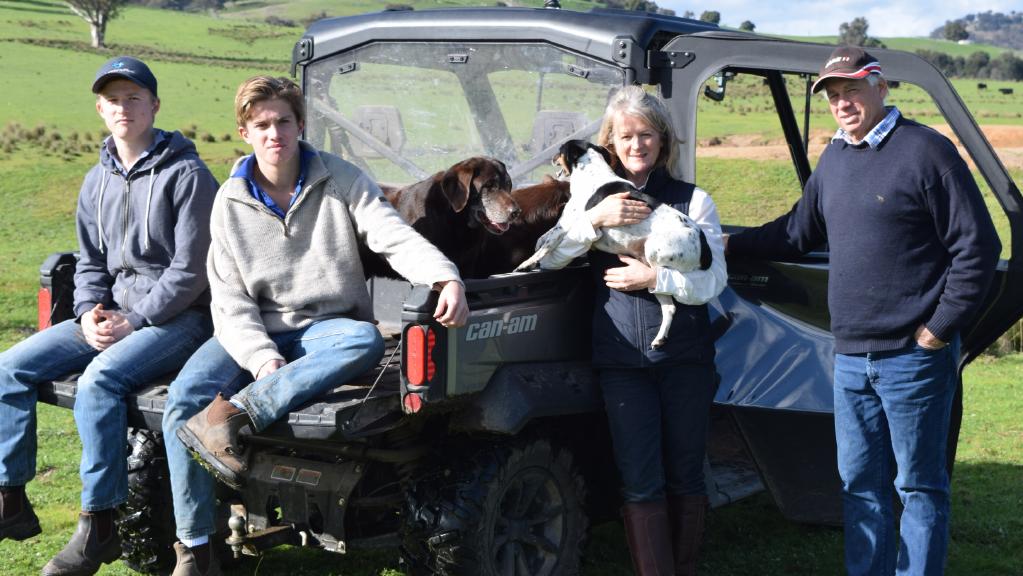QUEST FOR THE BEST
By Jamie-Lee Oldfield, The Weekly Times, August 2, 2017
A MOVE to the southwestern reaches of the Great Divide has delivered for the Maconochie family.
Jamie and Robina moved to Wymah, 50km northeast of Albury, NSW, and 4km from the mighty Murray River, almost seven years ago,
The 800ha of undulating land and natural springs is a world away from Victoria’s Western District, where the family started their farming journey.
And their 350 Team Te Mania Angus cow herd could not be happier, thriving in the environment and producing top-quality beef for Melbourne butchers.
The half-spring, half-autumn calving Angus herd is based on Te Mania genetics, with bulls leased from Te Mania for three-year periods.
Having previously run a large 4000 Angus cow herd for Japanese owners at Camperdown, Jamie was introduced to Te Mania bloodlines.
“The cows were artificially inseminated to Wagyu, and I went and purchased a lot of stud cows for the operation,” he said.
“The Japanese owners used to say that the Te Mania cows were by far producing the best performing Wagyu-cross calves in the feedlot.
“So I went straight into buying their females for my own herd, and went on from there — I now supply Melbourne butchers with beef.”

CALF MUSCLE
CALVES are weaned at nine months and then sent to be contract fed at Echuca for three months.
Jamie said while grain feeding them to slaughter weights cost $250 each, it allowed him to run more breeding females.
“I like to follow the cattle right through to slaughter, rather than someone else buying them and making money out of them,” Jamie said.
“I used to run calves out to about 18 months old but I find this much more profitable.”
Robina says grain feeding also ensures a more consistent quality product, year round.
“I am really supplying the market when they can’t get grass-fed calves, in July-August, and again in March-April,” Jamie said.
When the Angus steers and cull heifers reach 400kg liveweight, a price is negotiated with a buyer for a number of Melbourne butchers, and the stock is sent to Kyneton or Warragul abattoirs for slaughter and distribution.
Jamie used to deal direct with butchers, but has found having one meat buyer for several shops helps streamline distribution — and ensure payment.
Jamie said the price was always well above market value.
“When the market is good, like it has been lately, you could almost make the same profit by just selling the calves as stores, but I like to follow them through and get the feedback,” he said.
“I received carcass data for each individual electronic identification number from each beast when killed at Warragul, and I can link that back to the cow to see which is producing the best,” Jamie said.
FAMILY MATTERS
THE Maconochies, who are helped on farm by sons Angus and Henry, turn off upwards of 300 Angus cattle a year.
While a select few heifers are kept on, Jamie says he also likes to buy some in.
“It takes a long time to get money out of heifers, so I keep the very best and then sell some cull for age cows to buy some top-bred heifers to boost numbers,” he said.
Heifers are sent to feed receive hormone growth promotants, to keep them from going to fat, and are generally the first sent to slaughter, after 10 weeks on grain.
Those that remain are joined at 18 months, grown out slightly longer than the average operation to ensure they can handle their first calving.
The bulls run with the cows for eight weeks. Jamie selects bulls with a higher birthweight to produce a bigger calf, and said as long as the cows and heifers’ condition was handled correctly, they did not have calving problems.
“Don’t let them get too fat, and they will be fine — the hills here really help that, keeping them fit and not allowing them to put on too much condition,” he said.
Calves are weaned in a paddock you can see out kitchen window, where they are fed hay to encourage a quick catch on when introduced to grain.
The paddock is also in clear view of where the weaned calves’ mothers will reside.
“When they can see their mothers, they settle down in just a couple of days,” Robina said.
“I am not into yard weaning, we always wean where they can see their mothers, they just get so stressed otherwise.”
The pastures, well established before the Maconochies arrived on the property, are rotated as much as possible and Jamie says one of the key elements of good livestock management is “lightening off when you have to lighten off”.
“And I tend to really look after what your next income is — at the moment autumn calves,” he said.
BAA BRAWL
THE Maconochies also run up to 900 Border Leicester-Merino ewes on their 800mm rainfall property, joining them to Poll Dorset rams.
The first-cross ewes are bought in each year, either from local saleyards or more commonly now via AuctionsPlus, but always from well-known local producers.
Jamie, who admits he might actually enjoy sheep more than cattle, said the property was well equipped for sheep management when they arrived, and having the two enterprises spread the risk.
“There always has been more money in sheep than cattle, but cattle have now caught up,” he said.
However, one hurdle to producing sucker lambs, usually marketed at Corowa, has appeared in recent years.
The Maconochies have had three wild dogs destroyed on their property in one week recently and, as a result, the sheep have only been running on the low-lying areas, rather than the sheltered hills where plentiful native pastures grow.
“We leave them on low areas because it is a long way for dog to travel — the only way we have been able to get the wild dogs is for our local ranger to come and howl them,” Jamie said.
“We are going to have to electrify the whole boundary, which all the neighbours are doing now.”
- Member of Team Te Mania since 2004
- Beef Only
- Spring and Autumn calving







